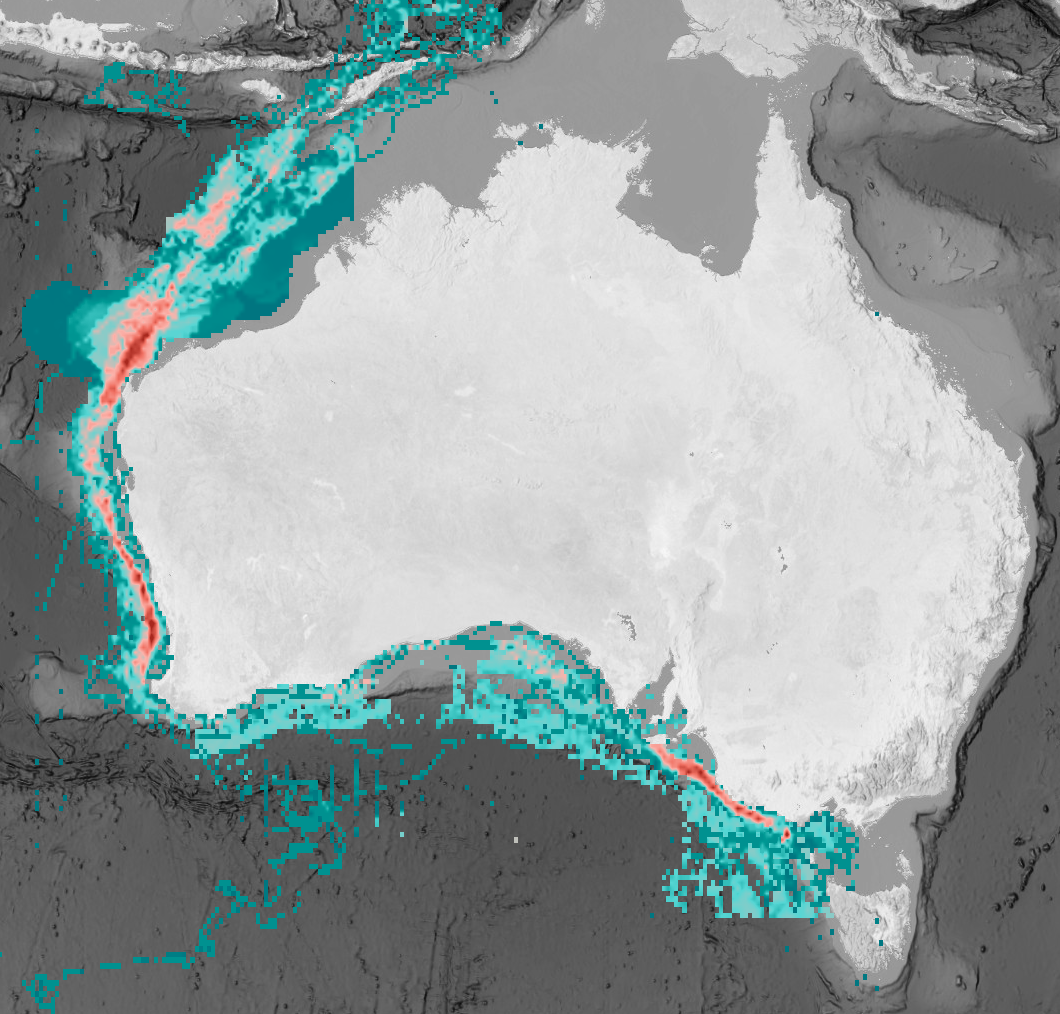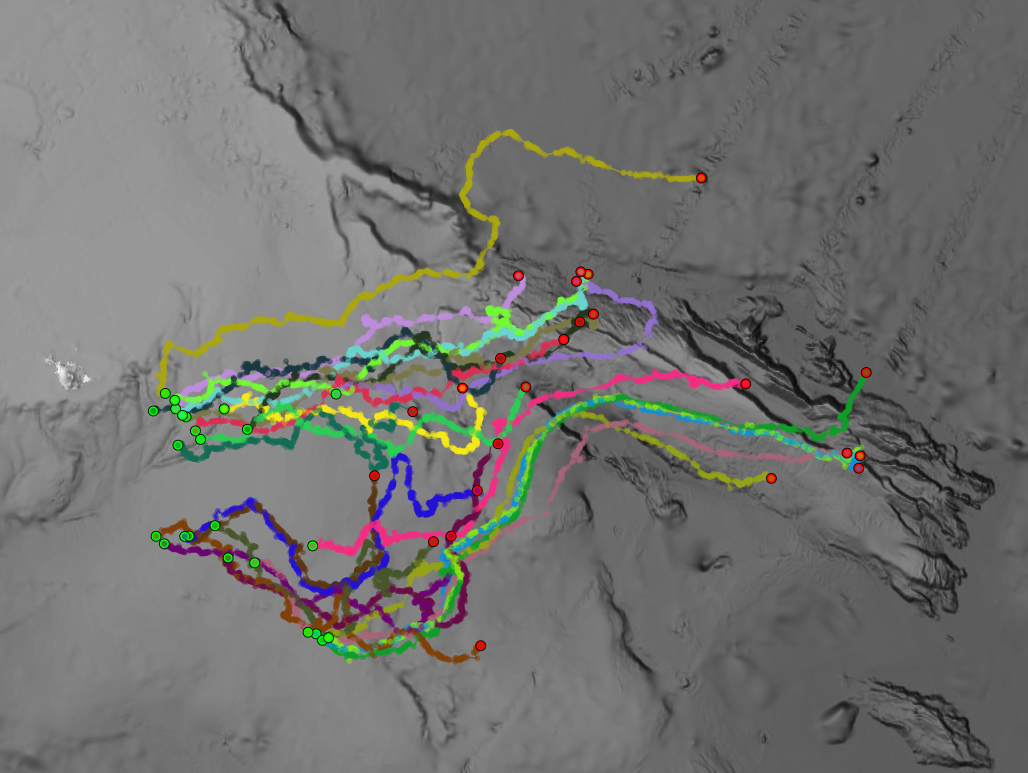ANIMAL ECOLOGY AND BEHAVIOR
Type of resources
Topics
Keywords
Contact for the resource
Provided by
Years
-

The offshore renewable energy (ORE) sector is rapidly developing in Australian waters to meet the country’s carbon emission targets. However, new developments in the marine environment pose added risk to threatened species. The Eastern Indian Ocean pygmy blue whale (Balaenoptera musculus brevicauda) was identified as a key species by the Australian Government for understanding the potential impacts of ORE developments. This subspecies ranges from the Subtropical Convergence (~40-45°S) to Southeast Asia (~2°S) with most of its documented distribution within the Australia Exclusive Economic Zone. Pygmy blue whale distribution overlaps various anthropogenic activities across their range, which suggests that some level of exposure to pressure and threats is likely. We compiled all available spatial data to quantify the full and foraging distribution of pygmy blue whales and quantified exposure to individual and cumulative threats across the species distribution. Threat exposure analysis included expert elicitation to gather expert input on the probability of exposure to a threat occurring from the spatial overlap between pygmy blue whale distribution and anthropogenic pressures, with a focus on areas undergoing ORE development. The cumulative exposure assessment indicated a relatively low level of exposure of pygmy blue whales to existing threats within Australian waters, particularly those that occur within declared ORE areas. However, several gaps in data and knowledge were identified that need to be addressed prior to development of the ORE industry. Our results provide a robust baseline that can be directly incorporated by industry and regulators as spatial layers into impact assessments. The study helps inform Government, and proponents of wind farms on the current state of knowledge of pygmy blue whale distribution and exposure to threats in Australian waters for use in decision-making, helping facilitate the sustainable development of the ORE industry in Australia.
-
This data is from experiments conducted at IMAS Taroona laboratories on predation of urchins by the Southern Rock Lobster. Four experiment types were conducted, including live urchins, urchin roe and trimmed urchins. This data is directly linked to a publication manuscript in preparation for submission to Animal Behaviour journal [link TBA].
-

Time series dataset of depth and activity recorded by miniPAT (Wildlife computers) popup satellite archival tags deployed on Kerguelen sandpaper skates (Bathyraja irrasa, n=24) caught in the Patagonian toothfish longline fishery in Heard Island and McDonald Islands. Tags were deployed to assess the post-release survival of skates in the fishery.
-
The Maugean Skate Zearaja maugeana is a micro-endemic species known from only two isolated estuaries, Bathurst and Macquarie Harbours in southwestern/western Tasmania. This constitutes one of the most limited distributions of any known extant elasmobranch. As a result, the species is listed as ‘Endangered’ under the Threatened Species Protection Act (Tasmania) and the Environmental Protection and Biodiversity Conservation Act (Commonwealth). Even though it was first discovered in Bathurst Harbour, most of what is known about the species comes from the Macquarie Harbour population. Only four individuals have ever been reported in Bathurst Harbour, with the last known sighting occurring in 1992. This study used environmental DNA (eDNA) to determine the presence/absence of the Maugean skate in Bathurst Harbour on the southwest coast of Tasmania. Water samples were collected from the seafloor in Bathurst Harbour in November 2021 and February 2022, and in Macquarie Harbour (control samples) in December 2021. Samples were filtered using a self-preserving eDNA sampling system. Following each survey DNA from the samples was extracted and analysed through qPCR amplification. Mitochondrial primer pairs from two gene regions were used to detect the presence of Maugean skate DNA in the samples. Where possible, positive detections were sequenced, and their identity verified.
-

This record provides an overview of the NESP Marine and Coastal Hub project "Mapping critical Australian sea lion habitat to assess ecological value and risks to population recovery". For specific data outputs from this project, please see child records associated with this metadata. -------------------- Australian sea lion populations have declined by more than 60% over the past four decades. Abundance and trends vary markedly across the species range, suggesting that localised risk profiles from threats - such as bycatch, marine pollution, and habitat degradation - vary at small spatial scales. Fine scale variation in habitat use is thought to underpin these differences, yet knowledge about Australian sea lion's dependency on key habitats and their vulnerability to human impacts is limited. This project deployed compact animal-borne cameras with GPS and motion sensors on eight adult female sea lions at two key colonies: Seal Bay (Southern Kangaroo Island Marine Park) and Olive Island (Western Eyre Marine Park). The devices recorded nearly 80 hours of footage over 560 km of seabed, identifying six distinct benthic habitat types, including previously unmapped rocky reefs and kelp forests. The footage was used to develop fine-scale habitat maps using machine learning models, providing a valuable baseline for assessing ecological value, foraging intensity, and the effectiveness of protected areas. This innovative approach complements traditional seafloor mapping and offers a scalable, cost-effective method for locating and monitoring critical habitats for endangered marine species. The results directly inform recovery planning, fisheries management, marine park design, and the identification of Biologically Important Areas. Ongoing camera deployments at Seal Bay and new sites along the western Eyre Peninsula will improve understanding of sea lion colony-specific behaviours and contribute to long-term monitoring of habitat change, diet, and emerging threats. Outputs • Tracking data from sea lion-deployed tags: location, depth, time, temperature, light, acceleration [dataset] • Timestamped video footage from sea lion-deployed cameras [dataset] • Final project report [written]
-

This project developed an interim Population Consequence of Disturbance (iPCoD) model for blue whales (Balaenoptera musculus) and southern right whales (Eubalaena australis) to document a methodology for assessing population-level impacts of one, or multiple, wind farm developments off the southern Australian coast. The iPCoD model was developed in Europe to quantify how disturbances of individuals caused by physiological injury or changes in behaviour can have population-level consequences in data poor marine mammal populations. This model was adapted to suit Australian marine mammal species, highlighting key data gaps for locally threatened populations that overlap in range with the declared offshore wind areas in Australia. Due to the lack of baseline data currently available, this study documented a framework that can be updated as more information becomes available. We outlined how to leverage simulation-based population modelling as a tool for policymakers, industry and management authorities, to aid in environmental impact assessments, with a specific focus on data poor marine mammal populations.
 IMAS Metadata Catalogue
IMAS Metadata Catalogue